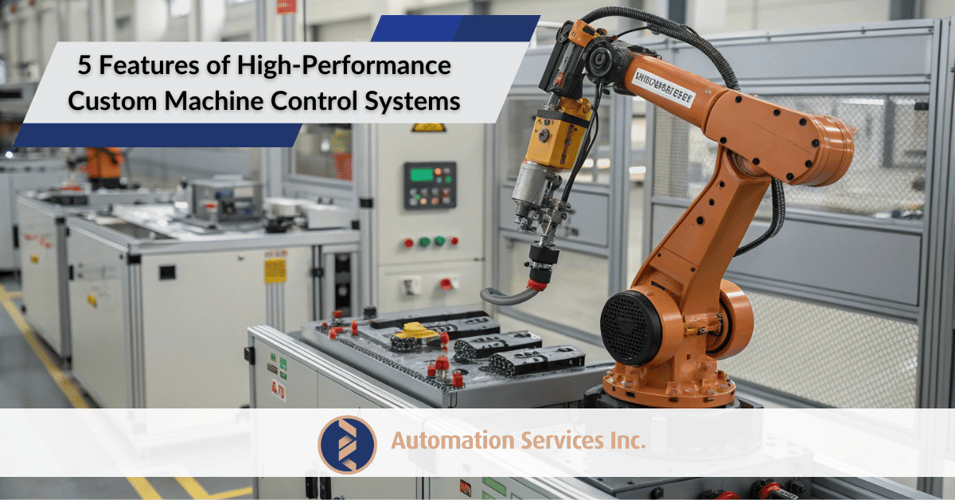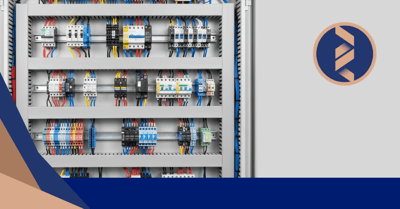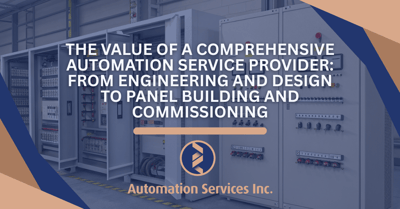5 Features of High-Performance Custom Machine Control Systems
Written by Automation Services Inc. | read
When it comes to industrial automation, High-Performance Control Systems are the backbone of precision, efficiency, and reliability. From maintaining seamless operations to scaling for future growth, these systems are crucial for automation system designers, production managers, and OEMs alike. But what features truly set these systems apart? Below, we’ll explore the five key attributes that define a High-Performance Automation system.
Precision Control and Accuracy
The hallmark of any High-Performance Control System is its ability to deliver precise control and unparalleled accuracy. These systems are designed to execute operations with minimal variability and maximum reliability.
- Advanced sensors and actuators work together to monitor and adjust system performance in real time.
- Algorithms enhance accuracy by reducing errors and deviations in processes like temperature regulation, speed modulation, or robotic arm positioning.
- Feedback loops immediately correct discrepancies, ensuring consistent output quality across operations.
For example, even a slight variation can lead to product inconsistencies in pharmaceutical production. Precision control ensures critical processes stay within stringent tolerances, optimizing quality and compliance.
Algorithms also improve operational efficiency by automating repetitive tasks and streamlining workflows. This saves time and resources, allowing companies to increase productivity and reduce costs. In manufacturing, algorithms can schedule production runs based on demand forecasts, optimizing inventory levels and minimizing downtime. Similarly, in logistics, algorithms can optimize delivery routes for maximum efficiency. Moreover, algorithms have revolutionized the advertising industry by enabling targeted marketing strategies based on consumer behavior data analysis.
Scalable Architecture
Flexibility and room for growth are essential in today’s fast-changing industrial landscape. Scalable Control Systems allow organizations to adapt to future demands without overhauling their infrastructure.
- Modular designs enable systems to be easily expanded or reconfigured, accommodating new equipment or increased production needs.
- Communication protocols like Ethernet/IP and Profinet ensure seamless integration across old and new machinery.
- Scalable computing power provides the capacity for advanced analytics without compromising speed or efficiency.
Production managers especially benefit from having Scalable Control Systems that can grow alongside their operations, minimizing downtime or costly upgrades. With the ability to easily integrate new equipment and expand or reconfigure systems, production managers can keep up with changing needs and technologies. Additionally, having access to advanced analytics through scalable computing power allows for better decision-making and optimization of processes. This ultimately leads to increased efficiency, cost savings, and improved overall performance.
Real-Time Monitoring and Diagnostics
The ability to identify and address issues before they escalate is a critical feature of High-Performance Automation systems. Real-time monitoring ensures ongoing visibility and swift reaction to fluctuations or errors.
- Sensor networks continuously track system performance, feeding data to central dashboards or control panel specs.
- Integrated software highlights potential issues, offering diagnostic reports and recommendations for corrective action.
- Predictive maintenance algorithms warn of equipment wear or performance drops, preventing costly breakdowns.
This capability allows operators to keep systems running smoothly, boosting uptime and operational efficiency. Continuous monitoring and maintenance is especially important in industries where any downtime can result in significant financial losses. For example, in the manufacturing sector, a sudden equipment breakdown can cause delays and disruptions in production lines, resulting in missed deadlines and lost revenue.
Furthermore, with advancements in machine learning and artificial intelligence, predictive maintenance has become more accurate and reliable. These algorithms can process large amounts of data from various sources and predict potential issues that may arise even before they occur. This proactive approach minimizes downtime and maximizes efficiency.
Compliance and Safety Features
Industrial settings demand adherence to strict industry regulations and safety protocols. High-Performance Control Systems prioritize both, ensuring safe and compliant operations.
- Built-in compliance checks align processes with standards like ISO 13849 or NEC standards for electrical systems.
- Safety features, such as emergency stop circuits, fail-safes, and dual-channel monitoring, protect workers and equipment alike.
- Secure access control ensures that only authorized personnel can manage or alter system settings.
By combining safety systems with up-to-date compliance measures, organizations can avoid regulatory penalties and foster a safer workplace. This allows organizations to allocate resources towards other areas of the business or invest in further automation efforts.
Remote Access and Data Integration
Finally, a defining feature of modern High-Performance Automation systems is their ability to support remote access and seamless data integration. Engineers and managers no longer need to be on-site to monitor or control systems.
- Secure remote access lets operators manage systems from any location, reducing response times during critical situations.
- Data integration across platforms enables a complete view of operations, aligning production systems with business goals.
- Centralized cloud-based control panels consolidate Machine Control Features, providing a unified and intuitive user experience.
This connectivity empowers decision-makers to optimize performance and gain actionable insights, even from afar.
Discover the Benefits of High-Performance Control Systems
If your organization is seeking a reliable partner to design and implement High-Performance Control Systems, Automation Services Inc. (ASI) is here to support you. With decades of expertise, we specialize in engineering tailored solutions that exceed expectations and align with your specific operational goals. Our commitment to quality, precision, and long-term reliability ensures that each system we deliver meets the highest industry standards.
We invite you to connect with our team to discuss your control system requirements in detail.
Visit www.asi-e.com or contact us directly at asi@asi-e.com to schedule a consultation.
Let’s build a smarter, more efficient future—together.



.png?width=400&name=Beyond%20Standard%20Panels_%20Customization%20and%20Advanced%20Features%20in%20Enclosed%20Industrial%20Control%20Panels%20(UL%20508A).png)
